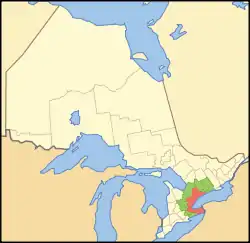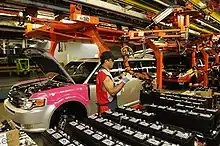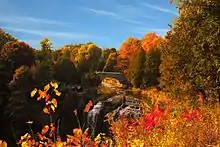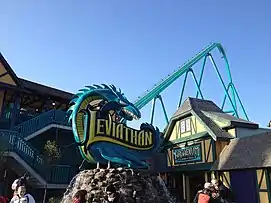Golden Horseshoe
The Golden Horseshoe is a secondary region of Southern Ontario, Canada, which lies at the western end of Lake Ontario, with outer boundaries stretching south to Lake Erie and north to Lake Scugog and Lake Simcoe. It includes the Greater Toronto Area and adjacent upper-tier municipalities with substantial urban agglomerations. The region is the most densely populated and industrialized in Canada. With a population of 7,826,367 people in its core and 9,245,438 in its greater area,[1] the Golden Horseshoe accounts for over 21 percent of the population of Canada and more than 55 percent of Ontario's population.[2] It is part of the Quebec City–Windsor Corridor, itself part of the Great Lakes Megalopolis.
Golden Horseshoe | |
|---|---|
Secondary region | |
.jpg.webp) Toronto is the anchor of the Golden Horseshoe. | |
 Location of the Golden Horseshoe in Ontario. ██ Core area ██ Greater Golden Horseshoe | |
| Coordinates: 43.6°N 79.73°W | |
| Country | Canada |
| Province | Ontario |
| Area | |
| • Total | 10,097.45 km2 (3,898.65 sq mi) |
| • Extended area | 21,464.12 km2 (8,287.34 sq mi) |
| • Combined | 31,561.57 km2 (12,185.99 sq mi) |
| Population (2016) | |
| • Total | 7,826,367 |
| • Density | 277.53/km2 (718.8/sq mi) |
| • Extended area | 1,843,117 |
| • Combined | 9,245,438 |
| Time zone | UTC−5 (EST) |
| • Summer (DST) | UTC−4 (EDT) |
| Postal code prefixes | |
| Area code(s) | 226, 249, 289, 365, 416, 437, 519, 548, 647, 705, 905 |
The core of the Golden Horseshoe starts from Niagara Falls at the eastern end of the Niagara Peninsula and extends west, wrapping around the western end of Lake Ontario at Hamilton and then turning northeast to Toronto (on the northwestern shore of Lake Ontario), before finally terminating at Clarington in Durham Region. The term Greater Golden Horseshoe is used to describe a broader region that stretches inland from the core to the area of the Trent–Severn Waterway, such as Peterborough, in the northeast, to Barrie and Lake Simcoe in the north, and to the Grand River area, including centres such as Brantford, Waterloo Region, and Guelph to the west. The extended region's area covers approximately 33,500 km2 (13,000 sq mi), out of this, 7,300 km2 (2,800 sq mi) or approximately 22 per cent of the area is covered by the environmentally protected Greenbelt. The Greater Golden Horseshoe forms the neck of the Ontario Peninsula.
Etymology

The horseshoe part of the region's name is derived from the characteristic horseshoe shape of the west end of Lake Ontario with Cootes Paradise between Burlington and Hamilton roughly positioned in the centre. The golden part is historically attributed to the region's wealth and prosperity, according to the Canadian Oxford Dictionary.[3]
The phrase Golden Horseshoe was first used by Westinghouse Electric Corporation president Herbert H. Rogge in a speech to the Hamilton Chamber of Commerce on January 12, 1954:
Hamilton in 50 years will be the forward cleat in a "golden horseshoe" of industrial development from Oshawa to the Niagara River ... 150 miles [240 km] long and 50 miles [80 km] wide ... It will run from Niagara Falls on the south to about Oshawa on the north and take in numerous cities and towns already there, including Hamilton and Toronto.[4]
The speech writer who actually penned the phrase was Charles Hunter MacBain, executive assistant to five Westinghouse presidents including Rogge.[5]
Definition
The Golden Horseshoe has been recognised as a geographic region since the 1950s, but it was only on July 13, 2004, that a report from the provincial Ministry of Public Infrastructure Renewal entitled Places to Grow coined the term Greater Golden Horseshoe, extending the boundaries west to Waterloo Region, north to Barrie/Simcoe County, and northeast to the county and city of Peterborough.[6] A subsequent edition released February 16, 2005, broadened the term further, adding Brant, Haldimand and Northumberland Counties to the now quasi-administrative region. The Greater Golden Horseshoe region is officially designated in Ontario Regulation 416/05[7] under the Places to Grow Act. The designation Greater Golden Horseshoe has legal significance with respect to taxation: in April 2017, the Government of Ontario announced plans to impose a 15 per cent Non-Resident Speculation Tax (NRST) on non-Canadian citizens, non-permanent residents and non-Canadian corporations (with exceptions or rebates for refugees, qualifying students and certain people working in Ontario[8]) buying residential properties containing one to six units in the Greater Golden Horseshoe (GGH).[9]
The provincial transit authority Metrolinx makes use of the term Greater Golden Horseshoe. The Metrolinx definition is consistent with the original 2004 Places to Grow definition. However, the city and county of Peterborough is not included.[10]
Demographics
The population of the Golden Horseshoe was 7.82 million residents at the 2016 census. The region is projected to grow to 11.5 million people by 2031.[11]
| Ethnic group | Population | % |
|---|---|---|
| European | 5,088,240 | 56% |
| South Asian | 1,068,520 | 11.8% |
| East Asian | 787,365 | 8.7% |
| African | 523,230 | 5.8% |
| Southeast Asian | 391,870 | 4.3% |
| Middle Eastern | 271,595 | 3% |
| Aboriginal | 198,140 | 2.2% |
| Latin American | 165,700 | 1.8% |
| Other | 202,945 | 2.2% |
| Total population (2016) | 9,245,438 | 100% |
Economy
The economy of this region is very diverse. The Toronto Stock Exchange is the third-largest in North America by market capitalization (after the New York Stock Exchange and NASDAQ), and seventh-largest in the world.[28]

Cities including Hamilton, Oshawa, Oakville, Whitby and Kitchener all contain major large-scale industrial production facilities, Hamilton being dominated by the steel industry and Oakville and Oshawa primarily in the automotive industry. Other significant automotive-production facilities also exist in Brampton, and St. Catharines. While manufacturing remains important to the economy of the region, the manufacturing sector has experienced a significant decline since 2000 as a result of unfavourable currency exchange rates, increasing energy costs, and reduced demand from the United States, which is by far the largest market for Ontario's goods.
The Port of Hamilton and the Port of Toronto are the two largest seaports on Lake Ontario. The Welland Canal system handles tanker ship and recreational traffic through the Great Lakes. Large rail and truck distribution facilities are located in Toronto, Vaughan and Brampton. Food processing is also a key ingredient in the economy.

Niagara Falls has one of the world's largest per-capita tourist economies, benefiting from millions of tourists coming to see its majestic waterfalls, shop in its numerous stores, and visit its many attractions. The winemaking and fruit growing industries of the Niagara Peninsula produce award-winning wines, which are beginning to attract attention around the world, in particular, the ice wine for which the region is known.
As of 2014, sectors such as information technology, health care, Agtech, tourism, research and finance provide the bulk of growth in the Golden Horseshoe. The suburban cities within Greater Toronto, such as Brampton, Markham, Waterloo Region and Mississauga, are emerging as hubs for technology and innovation.[29]
Since 2015, the Toronto–Waterloo Region Corridor is a hub for high-growth companies developing breakthrough discoveries.[30]
The Toronto-Waterloo Corridor is the largest tech cluster in North America outside of Silicon Valley. The area is home to more than 15,000 tech companies, including 5,000+ startups, and nearly 300,000 employees in high-tech industries. About two-thirds of those employees are classified as “tech workers,” which includes programmers, developers, etc. With 8% of the total workforce employed in tech, the Toronto-Waterloo Corridor also has a similar talent density to Silicon Valley and a much greater density than New York, Boston or Seattle.[31]
Education
The Golden Horseshoe is home to several universities, including the University of Toronto and McMaster University in Hamilton, which are ranked 1st and 4th in Canada, respectively, by the Academic Ranking of World Universities. Other universities in the region include Brock University in St. Catharines, Trent University in Peterborough, York University, OCAD University, University of Ontario Institute of Technology in Oshawa, Ryerson University, University of Guelph, University of Waterloo, Wilfrid Laurier University in Waterloo, and Université de l'Ontario français in downtown Toronto.
Public primary and secondary schooling is typically provided by school boards, largely organized at the municipal or county/regional level. The only school board that operates throughout the Golden Horseshoe is Conseil scolaire Viamonde, a public French-language school board, and Conseil scolaire catholique MonAvenir, a public French-language separate school board. Both of these public French-language school boards operate across the Ontario Peninsula.
Attractions
.jpg.webp)
Formerly the tallest freestanding structure on land in the world, the CN Tower in Toronto is among the most internationally notable attractions in the Golden Horseshoe.
The city is home to several shopping malls such as Yorkdale Shopping Centre, Toronto Eaton Centre (which is North America's busiest shopping mall),[32] Fairview Mall, Scarborough Town Centre, and Sherway Gardens. Located in the suburbs of Toronto are Vaughan Mills in Vaughan, Bramalea City Centre in Brampton and Square One Shopping Centre in Mississauga, the largest shopping mall in Ontario. Pacific Mall, in Markham, is the largest ethnic shopping mall in eastern Canada.
Annual cultural festivals that draw tourists and local alike include the Peeks Caribbean Carnival (formerly known as Caribana) and Taste of the Danforth in Toronto.

The Niagara Escarpment, a world biosphere reserve as designated by the United Nations, runs from the north at Bruce Peninsula and then east through the region cutting the Niagara Gorge at Niagara Falls. The Bruce Trail runs along the escarpment through mostly protected woodlands. The Cheltenham Badlands in Caledon is an environmentally degraded area along the Niagara Escarpment. Similar protection of some wooded areas exists on the Oak Ridges Moraine running east–west in the north end of the Greater Toronto Area, although development pressures continue to threaten the natural habitat.
The Niagara Region has become one of the major wine-production areas in Canada. The Golden Horseshoe contains many small towns with tourist-jammed, historic main streets, most notably the community of Niagara-on-the-Lake, located at the mouth of the Niagara River. Niagara Falls is one of the world's largest waterfalls, and attracts millions to Clifton Hill, a neighbourhood featuring hundreds of amusements, souvenir stores, restaurants and skyline-defining hotels. Casinos here are also a huge draw, particularly Casino Niagara and Fallsview Casino.
Hamilton has the historical reputation of being a blue-collar city; however, waterfront redevelopments and large-scale gentrification have been rapidly changing the perception of the city, although it retains a dominant industrial base. Hamilton has over 100 waterfalls and cascades throughout the region.

There are a number of theme parks in the Golden Horseshoe, all of which are seasonal. Canada's Wonderland, run by Cedar Fair in Vaughan, 2 km (1.2 mi) north of Vaughan Mills, is the largest and most attended theme park in Canada, as well as the most attended seasonal theme park in North America. Other theme parks include Wet'n'Wild Toronto (formerly Wild Water Kingdom) in Brampton, African Lion Safari in Hamilton and Cambridge, and Marineland in Niagara Falls. Though not a theme park per se, the Exhibition Place hosts the annual Canadian National Exhibition, which is Canada's largest annual fair.
Sports

The Golden Horseshoe is home to a number of amateur and professional sports clubs, and university and college varsity programs. Many professional sports clubs in the city form a part of a larger sports league. Most university varsity programs is regulated by U Sports, while college varsity programs are regulated by the Canadian Collegiate Athletic Association.
In addition to the number of sports clubs and programs based in the region, the Golden Horseshoe has also hosted a number of international multi-sport events, including the 1930 British Empire Games (predecessor to the Commonwealth Games), the 1976 Summer Paralympics, the 2015 Pan American Games and Parapan American Games, the 2017 Invictus Games, the 2017 North American Indigenous Games, and the 2018 NACAC Championships. Although the 1976 Summer Olympics was held in Montreal, several matches for the event's soccer tournament were played in Toronto.
Professional sports teams based in the Golden Horseshoe include:
| Team | City | League | Sport |
|---|---|---|---|
| Toronto Blue Jays | Toronto | Major League Baseball | Baseball |
| Toronto Maple Leafs | Toronto | Intercounty Baseball League | Baseball |
| Toronto Raptors | Toronto | National Basketball Association | Basketball |
| Raptors 905 | Mississauga | NBA G League | Basketball |
| Toronto Rock | Toronto | National Lacrosse League | Box lacrosse |
| Hamilton Tiger-Cats | Hamilton | Canadian Football League | Canadian football |
| Toronto Argonauts | Toronto | Canadian Football League | Canadian football |
| Brampton Beast | Brampton | ECHL | Ice hockey |
| Toronto Marlies | Toronto | American Hockey League | Ice hockey |
| Toronto Maple Leafs | Toronto | National Hockey League | Ice hockey |
| Toronto Six | Toronto | National Women's Hockey League | Ice hockey |
| Toronto Arrows | Toronto | Major League Rugby | Rugby union |
| Toronto FC | Toronto | Major League Soccer | Soccer |
| Toronto FC II | Toronto | USL League One | Soccer |
| Forge FC | Hamilton | Canadian Premier League | Soccer |
| York United FC | Toronto | Canadian Premier League | Soccer |
| Toronto Titans | Toronto | International Swimming League | Swimming |
Note that the Toronto Blue Jays and the Toronto Raptors are temporarily playing their home games in the United States due to the COVID-19 pandemic.
Transportation


The Golden Horseshoe is served by an network of expressways, the backbone of which are the Queen Elizabeth Way and Highway 401, one of the widest and busiest expressways in the world. Public transit in the region is coordinated by Metrolinx.[33] Regional transit is provided by GO Transit trains and buses, and by private bus operators Greyhound and Coach Canada. GO Transit's train network encompasses 7 commuter rail lines linking municipalities in the Golden Horseshoe to Toronto's Union Station, which is the busiest railway station in Canada and the second busiest railway station in North America, with 72 million passengers per year.[34] Expansion is underway to facilitate all-day 15-minute or better commuter train service, electrification and increased ridership on five of the busiest lines.[35] Local transit is provided by municipal agencies, the largest of which is the Toronto Transit Commission, which operates three subway lines and one light metro line and an extensive bus and streetcar network. Rapid transit systems outside Toronto include the VIVA bus rapid transit in York Region, the ION light rail system in Kitchener-Waterloo, and the Mississauga transitway. Line 5 and Line 6 are under construction LRT/subway lines in Toronto. The Hurontario LRT is currently under construction in Peel Region, as well as various bus rapid transit projects in Peel and York Regions.[36]
The primary airport of the region is Toronto Pearson International Airport (officially Lester B. Pearson International Airport), located in Mississauga. Handling 49.5 million passengers in 2018, it is the busiest in Canada and the 31st busiest in the world. Other regional airports of significance include John C. Munro Hamilton International Airport located in southern Hamilton, which is a major regional freight and courier location as well as the Region of Waterloo International Airport in Kitchener; Buttonville Airport and Billy Bishop airport in the Greater Toronto Area. Within driving distance is Buffalo Niagara International Airport in Cheektowaga, New York, in the United States. Buffalo Niagara carries the second largest passenger volume in the region, serving over 5 million passengers in 2018.[37] It is frequently used by Canadian passengers flying to US destinations.
Divisions
.jpg.webp)


Municipalities
| Section | Census division | Population in 2016 |
|---|---|---|
| Core | Durham Region | 645,862 |
| Core | Halton Region | 548,435 |
| Core | Hamilton | 536,917 |
| Core | Niagara Region | 447,888 |
| Core | Peel Region | 1,381,739 |
| Core | Toronto | 2,731,571 |
| Core | York Region | 1,109,909 |
| Core | Total core | 7,402,321 |
| Extended | Brant (County of Brant and Brantford) | 134,808 |
| Extended | Dufferin County | 61,735 |
| Extended | Haldimand County | 44,876 |
| Extended | Kawartha Lakes | 75,423 |
| Extended | Northumberland County | 85,598 |
| Extended | Peterborough (Peterborough County and the city of Peterborough) | 138,236 |
| Extended | Simcoe (Simcoe County, Barrie and Orillia) | 479,650 |
| Extended | Waterloo Region | 535,154 |
| Extended | Wellington (Wellington County and Guelph) | 222,726 |
| Extended | Total extended | 1,778,206 |
| Total | all | 9,180,527 |
Census metropolitan areas
Population figures are from the 2016 census.
The census metropolitan areas listed below are within the Greater Golden Horseshoe. Not all land within the Greater Golden Horseshoe is part of a Census Metropolitan Area; some Census Metropolitan Areas are partly in the Golden Horseshoe and partly outside it.
References
- Canada, Government of Canada, Statistics. "Table 1.1Population and demographic factors of growth by census metropolitan area, Canada". www.statcan.gc.ca. Retrieved 2018-01-30.
- "Portrait of the Canadian Population in 2006: Subprovincial population dynamics, Greater Golden Horseshoe". Statistics Canada, 2006 Census of Population. 2007-03-13. Retrieved 2007-03-13.
- Barber, Katherine, ed. (2005). "Golden Horseshoe". Canadian Oxford Dictionary (2nd ed.). Oxford University Press. ISBN 9780195418163. Retrieved 11 September 2017.
ORIGIN: So called with reference to the area's wealth and horseshoe-like shape.
- "Fast Facts from Hamilton's Past". Archived from the original on 2006-09-05. Retrieved 2007-01-08.
- Strada, Eric. "Looking Back: The Golden Truth". Biz Magazine. Postmedia Network. Retrieved September 13, 2017.
- "Places to Grow". Archived from the original on 2006-09-07. Retrieved 2006-09-13.
- "Places to Grow Act, 2005 - Ontario Regulation 416/05 - Growth Plan Areas". Government of Ontario. Retrieved January 30, 2019.
- Marr, Garry. "Ontario slaps 15% tax on foreign buyers, expands rent control in 16-point plan to cool housing". Financial Post. Retrieved 30 April 2017.
- Office of the Premier (April 20, 2017). "News Release: Making Housing More Affordable". Queen's Printer for Ontario. Retrieved 30 April 2017.
introducing a 15 per cent Non-Resident Speculation Tax (NRST) on non-Canadian citizens, non-permanent residents and non-Canadian corporations buying residential properties containing one to six units in the Greater Golden Horseshoe (GGH).
- "For a Greater Region". Metrolinx. Retrieved June 30, 2018.
- "Greater Golden Horseshoe, GTA and Hamilton Population, Household and Employment Forecasts" (PDF). Regional Municipality of York. February 2005. Archived from the original (PDF) on July 6, 2011.
- "Census Profile, 2016 Census - Northumberland, County [Census division], Ontario and Ontario [Province]".
- "Census Profile, 2016 Census - Peterborough, County [Census division], Ontario and Ontario [Province]".
- "Census Profile, 2016 Census - Simcoe, County [Census division], Ontario and Ontario [Province]".
- "Census Profile, 2016 Census - Wellington, County [Census division], Ontario and Ontario [Province]".
- "Census Profile, 2016 Census - Dufferin, County [Census division], Ontario and Ontario [Province]".
- "Census Profile, 2016 Census - Durham, Regional municipality [Census division], Ontario and Ontario [Province]".
- "Census Profile, 2016 Census - Halton, Regional municipality [Census division], Ontario and Ontario [Province]".
- "Census Profile, 2016 Census - Niagara, Regional municipality [Census division], Ontario and Ontario [Province]".
- "Census Profile, 2016 Census - Toronto, City [Census subdivision], Ontario and Toronto, Census division [Census division], Ontario".
- "Census Profile, 2016 Census - Waterloo, Regional municipality [Census division], Ontario and Ontario [Province]".
- "Census Profile, 2016 Census - Hamilton, City [Census subdivision], Ontario and Hamilton, Census division [Census division], Ontario".
- "Census Profile, 2016 Census - Haldimand County, City [Census subdivision], Ontario and Haldimand-Norfolk, Census division [Census division], Ontario".
- "Census Profile, 2016 Census - Kawartha Lakes, City [Census subdivision], Ontario and Kawartha Lakes, Census division [Census division], Ontario".
- "Census Profile, 2016 Census - Brant, City [Census subdivision], Ontario and Brant, Census division [Census division], Ontario".
- "Census Profile, 2016 Census - Peel, Regional municipality [Census division], Ontario and Ontario [Province]".
- "Census Profile, 2016 Census - York, Regional municipality [Census division], Ontario and Ontario [Province]".
- "Toronto Stock Exchange is the Third Largest in North America". 2Ontario.com. Archived from the original on February 11, 2007.
- "Innovation & Technology". www.brampton.ca.
- "The Corridor". thecorridor.ca.
- EDC, Waterloo. "What is the Toronto-Waterloo Corridor?". blog.waterlooedc.ca.
- "Canadian Shopping Centre Study" (PDF). Retail Council of Canada. December 2016. Retrieved 18 January 2017.
- "About Us". Metrolinx. Retrieved June 30, 2018.
- (PDF). 2016-05-08 https://web.archive.org/web/20160508141957/http://www.gotransit.com/public/en/aboutus/QF_InfoToGo_EN_03-15-v3.pdf. Archived from the original (PDF) on 2016-05-08. Retrieved 2020-09-17. Missing or empty
|title=(help) - "Metrolinx: It's Happening - GO Expansion". www.metrolinx.com. Retrieved 2020-09-17.
- "Metrolinx: For a Greater Region - Projects". www.metrolinx.com. Retrieved 2020-09-17.
- "BNIA celebrates major milestone". wgrz.com.
External links
 Golden Horseshoe travel guide from Wikivoyage
Golden Horseshoe travel guide from Wikivoyage- The City Of Waterfalls
